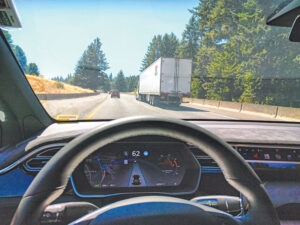Combining a comfortable and spacious interior and an aesthetic exterior defines modern vehicles, creating an all-encompassing experience that prioritizes style and comfort. In pursuit of this, car manufacturers are using the latest technologies to significantly enhance both the exterior and interior design of cars, emphasizing convenience, functionality, and user experience.
Throughout the years, the interior of a vehicle has evolved from driver and passenger seats into a functional space where technology, comfort, and aesthetics converge. Modern car interiors are designed, not only to allow people to drive but also to offer a better driving experience, convenience to the passengers, and cutting-edge features that integrate all the latest technologies in a single automobile.
One of the rising trends for car exteriors is the newly developed Advanced Driver Assistance Systems (ADAS). With concerns for sustainability, new materials, finishes, colors, textures, and emerging technology integrations, ADAS in modern cars is expected to provide implications for vehicle design.
While there are autonomous vehicles (AV) available in the market, the Society of Autonomous Engineers explains that high-level vehicle simulation still faces a long and winding road, noting that “safety and robustness are critical in automated driving.”
Sustainable fabric choices are becoming more popular with car manufacturers as well. Several brands are slowly transitioning away from traditional materials used for car interiors in favor of more environment-friendly options. Animal-free alternatives to leather, recycled materials, and even pineapple fibers are set to level up car interiors without causing more damage to the environment.
Backup camera displayed in digital instrument panel — Photo by Badgernet | Wikimedia Commons
More screens are also expected to be integrated into modern vehicles. With digital technology becoming more advanced and in demand, car interiors can potentially feature larger, more ergonomic display panels and touchscreens and fewer buttons, knobs, and compartments.
As beverages like coffee and tea become more fashionable, heated and cooled cup-holders in vehicle interiors are slowly becoming mainstream. Ensuring that drinks remain at the desired temperature throughout the drive, these innovations add an extra layer of comfort and hydration to the driving experience.
Meanwhile, despite their muscly and robust looks, car exteriors are not all about appearance. While aesthetics attract most car buyers to an automotive, a car’s exterior plays a huge role in preserving its value, protecting against environmental damage, and enhancing overall performance.
In line with almost any other industry, one of the more necessary adjustments that car manufacturers must accommodate is to make their automobiles sustainable and cut fuel consumption. Redefining car aerodynamics that is efficient, sustainable, and stylistic has led to a trend in vehicles with broad shapes, low ride height, and lightweight construction that aims to make the car’s interior spacious and improve its aerodynamic performance.
With the evolution of glass technologies, panoramic car roofs are also emerging as a trend for car exteriors. These glass roofs allow natural light to flood the cabin and provide a sense of openness and spaciousness to the interior. The sought-after feature adds a touch of sophistication to the driving experience while connecting occupants with the environment.
The functionality of doors is also becoming realized as more and more car manufacturers produce more double-door cars. Swing-out double doors grant modern five-seater cars four-door access without taking up the body space or adding extra weight as in the traditional models.
Another bright spot for car exterior designs is the aggressive and stylish headlights that give ordinary vehicles a sports car-like look. Car manufacturers have given emphasis on producing high-output lighting technology that consumes relatively less amount of power. These sleek, angular headlights not only contribute to the overall aesthetic appeal of the vehicle but also enhance visibility and safety on the road.
These emerging trends and more innovations are infused into the lineup of several automotive manufacturers. Hyundai, for instance, offers automobiles that blend near-luxury experience with a robust commitment to sustainability and innovation, offering something for every type of driver.
Hyundai NPX1 — Photo from hyundai-n.com
Hyundai’s NPX1 is the first concept model based on its award-winning IONIQ 5 N high-performance electric car. The new model sports aesthetic enhancements and features performance upgrades such as lightweight hybrid carbon wheels and high-performance brake pads, promising a smooth driving experience.
Moreover, Hyundai’s Sonata showcases the premium placed by the company on both luxury and practicality regarding the interior and comfort aspects of their vehicles. The Sonata offers 46.1 inches of legroom for front-row passengers and almost 35 inches for those in the second row while providing premium cloth upholstery, and power-adjustable seats with lumbar support.
Additionally, Hyundai’s Tucson and Palisade provide their owners with the company’s latest innovations as they feature an Intuitive dashboard layout with a touchscreen infotainment system and dual automatic temperature control as standard features. The Tucson also offers customizable 64-color LED ambient lighting for a more personalized touch. — Jomarc Angelo M. Corpuz
